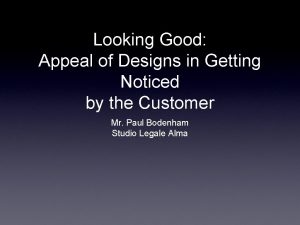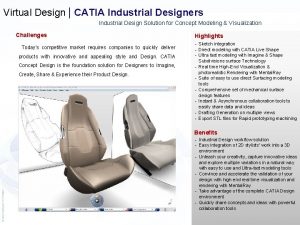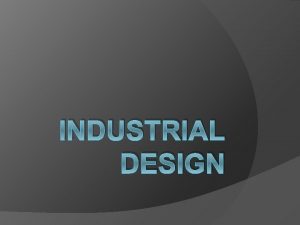Getting Noticed The Importance of Industrial Design Protection





















- Slides: 21

Getting Noticed: The Importance of Industrial Design Protection Mr. Rahul Beruar LAKSHMIKUMARAN & SRIDHARAN

“Good design is good business” Tom Watson, Jr. , the former chairman of IBM at Wharton Business School in 1973 LAKSHMIKUMARAN & SRIDHARAN

What is Industrial Design • The ornamental or artistic aspect of an article • Made up of three-dimensional features, such as the shape or surface of an article, or of two-dimensional features, such as patterns, lines or color. • An integration of art and Design, whereby mass produced products are improved for marketability and production. LAKSHMIKUMARAN & SRIDHARAN

The Designs Act, 2000. • Section 2 of the Design Act, 2000 “Design means only the features of shape, configuration, pattern ornament or composition of lines or colours applied to any article whether in two dimensional or three dimensional or in both forms, by any industrial process or means, whether manual, mechanical or chemical, separate or combined, which in the finished article appeal to and are judged solely by the eye; but does not include any mode or principle of construction or anything which is in substance a mere mechanical device” “article means any article of manufacture and any substance, artificial, or partly artificial and partly natural and includes any part of an article capable of being made and sold separately” LAKSHMIKUMARAN & SRIDHARAN

Criteria for Registration of Industrial Design under the Designs Act, 2000. A design which: • Is new or original • Has not been disclosed to the public by publication in tangible form or by use or in any other way prior to the filing date. • Is significantly distinguishable from known designs or combination of known designs. LAKSHMIKUMARAN & SRIDHARAN

What is a Industrial Design Right • A statutory Right which protects the aesthetic appeal of an article. • Design Right is a limited period Right. • In India registered Design is protected for a maximum period of Fifteen Years. LAKSHMIKUMARAN & SRIDHARAN

Advantages of Registration • A valuable business asset that can be bought, sold, transferred or licensed like any other property. • Provides the basis for taking legal action. • Grants exclusive right for 15 years. • Prevents others from copying or imitating the design. • Adds value to the product. • Makes it attractive to customers. LAKSHMIKUMARAN & SRIDHARAN

Copyright Act: Protection of Industrial Design • Copyright subsists in an Industrial Design only if it is an ‘artistic work’ under the Copyright Act. • Protection under the Copyright Act is available only when the aesthetic design of the product is separable from the product's function. • No necessity of registration, under the Copyright Act, to secure copyright in such Design. • Copyright in the Design subsists for the life of the artist plus 60 years. LAKSHMIKUMARAN & SRIDHARAN

Difference between Design Right and Copyright for a Industrial Design Right The Design Right is valid for a period of Maximum 15 Years. Copyright The Copyright subsists for a period of 60 years plus life of the author. Registration is required for No registration is required obtaining statutory relief. for obtaining statutory relief. Reproduction is restricted only to the article consisting of the Registered Design. Reproduction is Restricted to all forms including articles. LAKSHMIKUMARAN & SRIDHARAN

Protection of Industrial Design through Trademark • Trademark Act can be used to protect industrial designs in cases where the design has acquired distictiveness, i. e. secondary meaning and people associate the design with the source/ origin of the product. • Industrial Design may be protected as a Trademark and renewed every ten years. LAKSHMIKUMARAN & SRIDHARAN

Importance of Industrial Design • Makes it attractive and appealing to customers. • Key factor in the decision of a customer to buy the product. • Distinguishes a product where there is a wide range of products performing the same function, such as cars and computers. • Are business assets and increase the commercial value of a company and its products. LAKSHMIKUMARAN & SRIDHARAN

Successful Industrial designs Beetle Ipod Segway Syringe Nokia Phone LAKSHMIKUMARAN & SRIDHARAN

Case Study – Purple Pill • Purple Pill - a prescription drug Prilosec manufactured by Astra. Zeneca for relief from heartburn caused by acid reflux disease. • An huge marketing campaign was carried out in 1997, where advertisements for the “Purple Pill” appeared everywhere—on TV, the Internet, and in print ads. • The whole advertising campaign was centered on the colour of the Pill. • The advertisement resulted in consumers identifying the pill with its colour and not the name. LAKSHMIKUMARAN & SRIDHARAN

Case Study – Purple Pill • The marketing strategy was successful • First ever drug to hit $5 Billion Dollars 1 a year in worldwide sales. • The Patent for Purple pill expired in 2001. • Astra. Zeneca then replaced Prilosec with Nexium as a new prescription drug. • Nexium was also supported with an aggressive marketing focusing on the colour of the Pill. • In 2004 the sales of Nexium reached $3. 9 Billion Dollars 2. 1. Neil Swidey, The Costly Case of the Purple Pill—The Story of One Blockbuster Heartburn Drug Tells You Everything You Need To Know About the High Cost of Prescription Medicine, BOSTON GLOBE, Nov. 17, 2002, 2. David Seemungal, On the Mend at Astra. Zeneca, BUSINESS WEEK ONLINE, Aug. 9, 2005 LAKSHMIKUMARAN & SRIDHARAN

Case Study – Purple Pill • A color of a pill is usually arbitrarily selected by the manufacturer and is unrelated to the efficacy of the ingredients contained in the pill. • A color scheme when aggressively marketed by a manufacturer creates a association in the mind of the consumers with regard to the source of the product. LAKSHMIKUMARAN & SRIDHARAN

Case Study – Purple Pill SK&F Co. v. Premo Pharmaceutical Laboratories, Inc • Premo Pharmaceutical Laboratories, Inc. appealed an order prohibiting it from marketing a combination drug, in capsules having the same maroon and white color combination as the capsule used by SK&F, Co. (SKF) in marketing its product containing the same combination drug. LAKSHMIKUMARAN & SRIDHARAN

Case Study – Purple Pill SK&F Co. v. Premo Pharmaceutical Laboratories, Inc The Third Circuit Court held: – A unique color scheme employed by a brand name pharmaceutical manufacturer for their pills could not be imitated by the manufacturer of a generic equivalent. – “Proof of non functionality serves no purpose other than identification” and that, in the case of drugs, “the nonfunctional element must not enhance efficacy. ” – Color scheme was arbitrary and not related to performance or processing of the Drug. – The color scheme of the Pill had acquired a protectable secondary meaning. LAKSHMIKUMARAN & SRIDHARAN

Case Study – Purple Pill Shire U. S. , Inc. v. Barr Laboratories, Inc. • Shire U. S. , Inc. , manufactured a drug to treat attention deficit hyperactivity disorder (ADHD) under the brand name “Adderall. ” • The pills were marketed in various strengths, and color and size of the pills varied with pill strength. • All the pills were marked “AD” on one side, and the dosage size (in milligrams) were marked on the other side. LAKSHMIKUMARAN & SRIDHARAN

Case Study – Purple Pill Shire U. S. , Inc. v. Barr Laboratories, Inc. • Barr Laboratories in February 2002, began marketing a generic version of Adderall. • Barr marketed their generic equivalent in different dosages, and mirrored the color, shape, and dosage combinations of Shire's Adderall product. LAKSHMIKUMARAN & SRIDHARAN

Case Study – Purple Pill Shire U. S. , Inc. v. Barr Laboratories, Inc. The Third Circuit Court held: – Shire has failed to prove the requisite non-functionality of their unique color scheme. – similarity in pill appearance between Adderall and its generic counterpart both enhanced patient safety by allowing them to readily identify the pills and dosages by color. – The Court did not address the question of whether or not Shire had achieved secondary meaning for the pill's color scheme. LAKSHMIKUMARAN & SRIDHARAN

LAKSHMIKUMARAN & SRIDHARAN
 The secret to getting ahead is getting started
The secret to getting ahead is getting started Vocab unit 12 level d
Vocab unit 12 level d What inclusions have you noticed
What inclusions have you noticed A whale watching company noticed that many customers
A whale watching company noticed that many customers Ap biology standard deviation
Ap biology standard deviation Things i have noticed
Things i have noticed Darwin noticed that many organisms seemed well suited to
Darwin noticed that many organisms seemed well suited to Note on industrial estate
Note on industrial estate Factors of industrial relations
Factors of industrial relations Hình ảnh bộ gõ cơ thể búng tay
Hình ảnh bộ gõ cơ thể búng tay Slidetodoc
Slidetodoc Bổ thể
Bổ thể Tỉ lệ cơ thể trẻ em
Tỉ lệ cơ thể trẻ em Voi kéo gỗ như thế nào
Voi kéo gỗ như thế nào Tư thế worm breton là gì
Tư thế worm breton là gì Hát lên người ơi
Hát lên người ơi Các môn thể thao bắt đầu bằng tiếng nhảy
Các môn thể thao bắt đầu bằng tiếng nhảy Thế nào là hệ số cao nhất
Thế nào là hệ số cao nhất Các châu lục và đại dương trên thế giới
Các châu lục và đại dương trên thế giới Cong thức tính động năng
Cong thức tính động năng Trời xanh đây là của chúng ta thể thơ
Trời xanh đây là của chúng ta thể thơ Mật thư tọa độ 5x5
Mật thư tọa độ 5x5









































